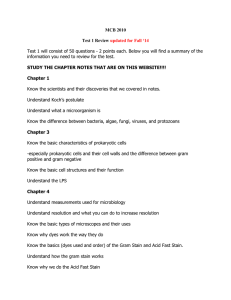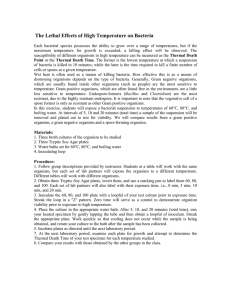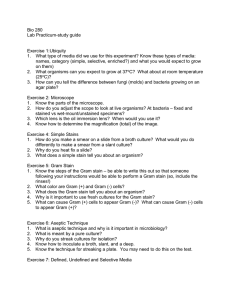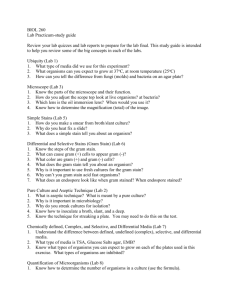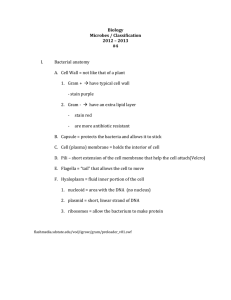BIOL 260 Lab Practicum-study guide
advertisement
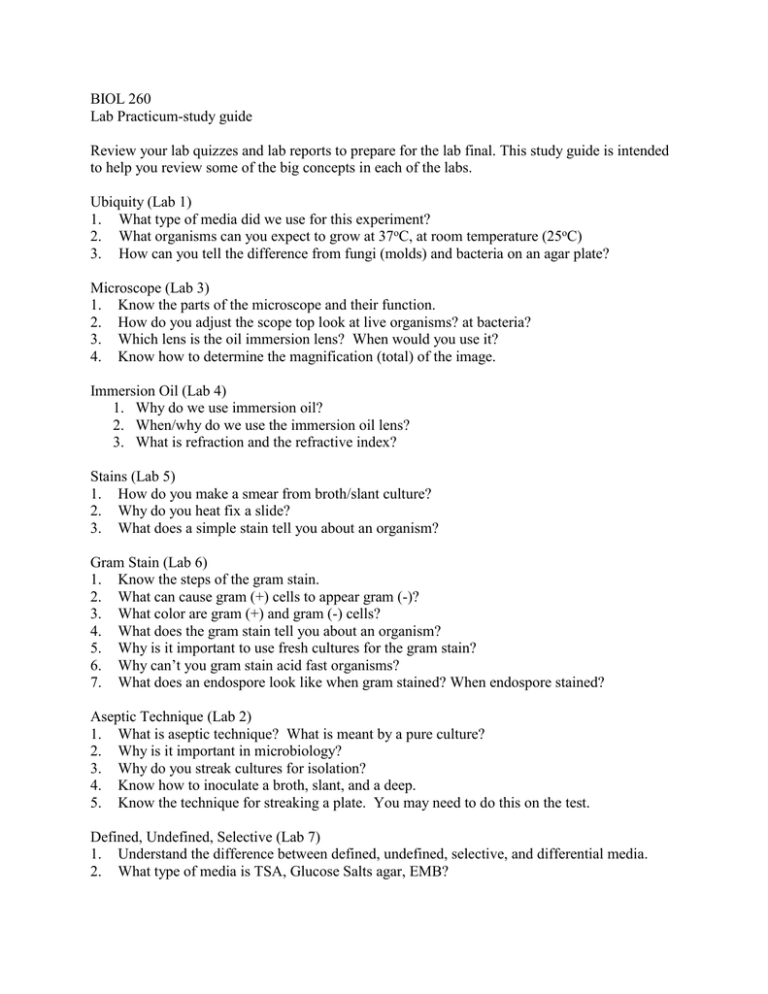
BIOL 260 Lab Practicum-study guide Review your lab quizzes and lab reports to prepare for the lab final. This study guide is intended to help you review some of the big concepts in each of the labs. Ubiquity (Lab 1) 1. What type of media did we use for this experiment? 2. What organisms can you expect to grow at 37oC, at room temperature (25oC) 3. How can you tell the difference from fungi (molds) and bacteria on an agar plate? Microscope (Lab 3) 1. Know the parts of the microscope and their function. 2. How do you adjust the scope top look at live organisms? at bacteria? 3. Which lens is the oil immersion lens? When would you use it? 4. Know how to determine the magnification (total) of the image. Immersion Oil (Lab 4) 1. Why do we use immersion oil? 2. When/why do we use the immersion oil lens? 3. What is refraction and the refractive index? Stains (Lab 5) 1. How do you make a smear from broth/slant culture? 2. Why do you heat fix a slide? 3. What does a simple stain tell you about an organism? Gram Stain (Lab 6) 1. Know the steps of the gram stain. 2. What can cause gram (+) cells to appear gram (-)? 3. What color are gram (+) and gram (-) cells? 4. What does the gram stain tell you about an organism? 5. Why is it important to use fresh cultures for the gram stain? 6. Why can’t you gram stain acid fast organisms? 7. What does an endospore look like when gram stained? When endospore stained? Aseptic Technique (Lab 2) 1. What is aseptic technique? What is meant by a pure culture? 2. Why is it important in microbiology? 3. Why do you streak cultures for isolation? 4. Know how to inoculate a broth, slant, and a deep. 5. Know the technique for streaking a plate. You may need to do this on the test. Defined, Undefined, Selective (Lab 7) 1. Understand the difference between defined, undefined, selective, and differential media. 2. What type of media is TSA, Glucose Salts agar, EMB? 4. Know what types of organisms you can expect to grow on each of the plates used in this exercise. What types of organisms are inhibited? Viable Cell Count (Lab 8) 1. Know how to determine the number of organisms in a culture (use the formula). 2. Know how to calculate the dilution of a sample within an individual tube. 3. Why is it necessary to dilute the culture? 4. What are the parameters for choosing a plate within a series to do the calculations? Aerobic/Anaerobic (Lab 9) 1. What was the purpose of this lab? 2. Understand the difference between aerobic, anaerobic, facultative organisms. 3. Be able to identify the type of organism growing in a shake/agar deep tube. 4. Why were shake tubes used for this exercise and not agar plates or broth? UV light (Lab 12) 1. What effect does UV light have on bacteria? 2. Be able to read a series of plates that have been exposed to UV light. What can you use as a control? 3. What types of organisms should be more resistant to UV light? More sensitive? Antimicrobial Drugs /Disinfectants (Labs 14 and 15) 1. What are the clear zones around the antibiotic discs called? 2. What does the Kirby-Bauer test tell you about an organism? 3. How do you determine antibiotic resistance or sensitivity of the organism? 4. Be able interpret the results from plates with different antibiotics or disinfectants/antiseptics. 5. Which are generally more effective: antiseptics or disinfectants? Transformation (Lab 17) 1. What was the purpose of this lab? 2. What is transformation? 3. What was the source of the DNA? 4. What were the positive controls used in the lab? Why are they important? 5. Which combination on the plates demonstrated the actual transformation? 6. How did you determine if transformation actually occurred? Normal Skin flora (Lab 22) 1. What types of organisms were we looking for in this exercise? 2. Why did we incubate some plates in the anaerobic chamber? 3. What types of organisms could grow on both the aerobic and anaerobic plate? 4. Why did we use a shake tube? 5. What does a (+) glucose brom cresol purple slant look like? What does that tell you about the organism? Throat culture (Lab 23) 1. What types of organisms are normal flora of the throat? What type of agar was used? 2. Be able to identify the different types of hemolysis on a blood agar plate. 3. What type(s) of hemolysis are considered normal flora? potential pathogens? Gram negative rods (Lab 24) 1. What color is a (+) phenol red fermentation test? What does a (+) test tell you about the organism? 2. What is the indicator in the phenol red fermentation test? What does it indicate? 3. What does the durham tube tell you? 4. Understand the significance between the MR and VP tests. 5. Be able to read a positive and negative test for each of the biochemical tests used in this lab. 6. Know whether or not you need to add a reagent to the test. Are there any pH indicators? 7. Understand what each test is telling you about the organism. Water test (Lab 29) 1. Be able to interpret an MPN test - which lactose tubes are positive? 2. What is the MPN index? 3. Why do you plate (+) BGLB tubes onto LES Endo plates? 4. Be able to interpret a culture growing on an LES Endo plate. 5. What types of organisms are you looking for in the water test? Why? Epidemiology lab (30) 1. What are fomites? 2. How is this lab mimicking the spread of a communicable disease? 3. How do we determine which people were “infected” with Serratia marcescens?
